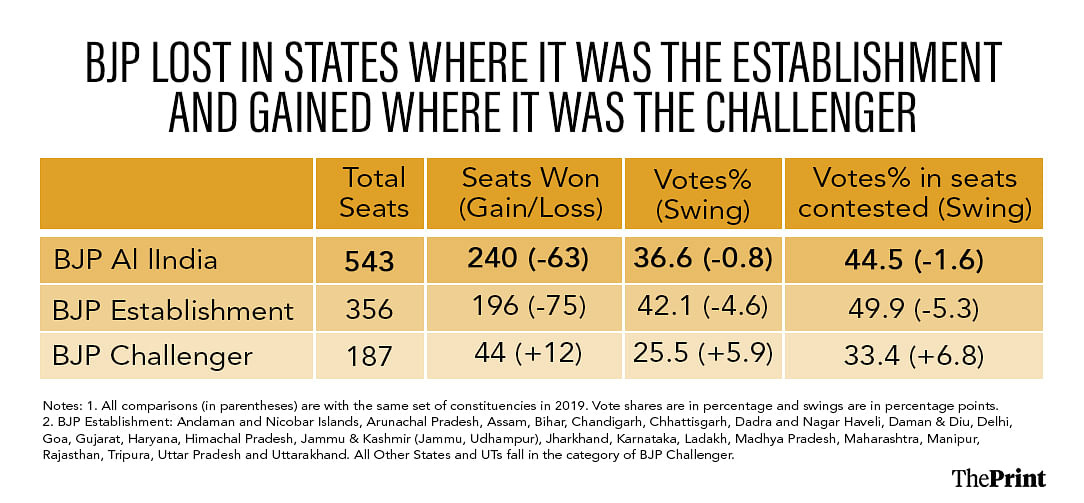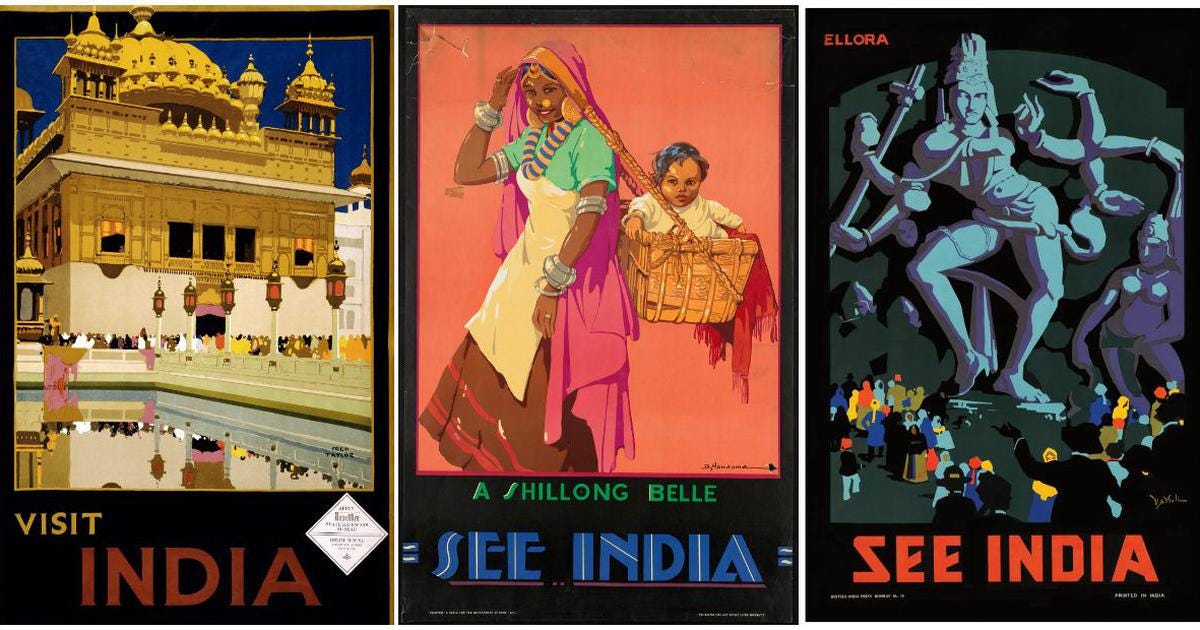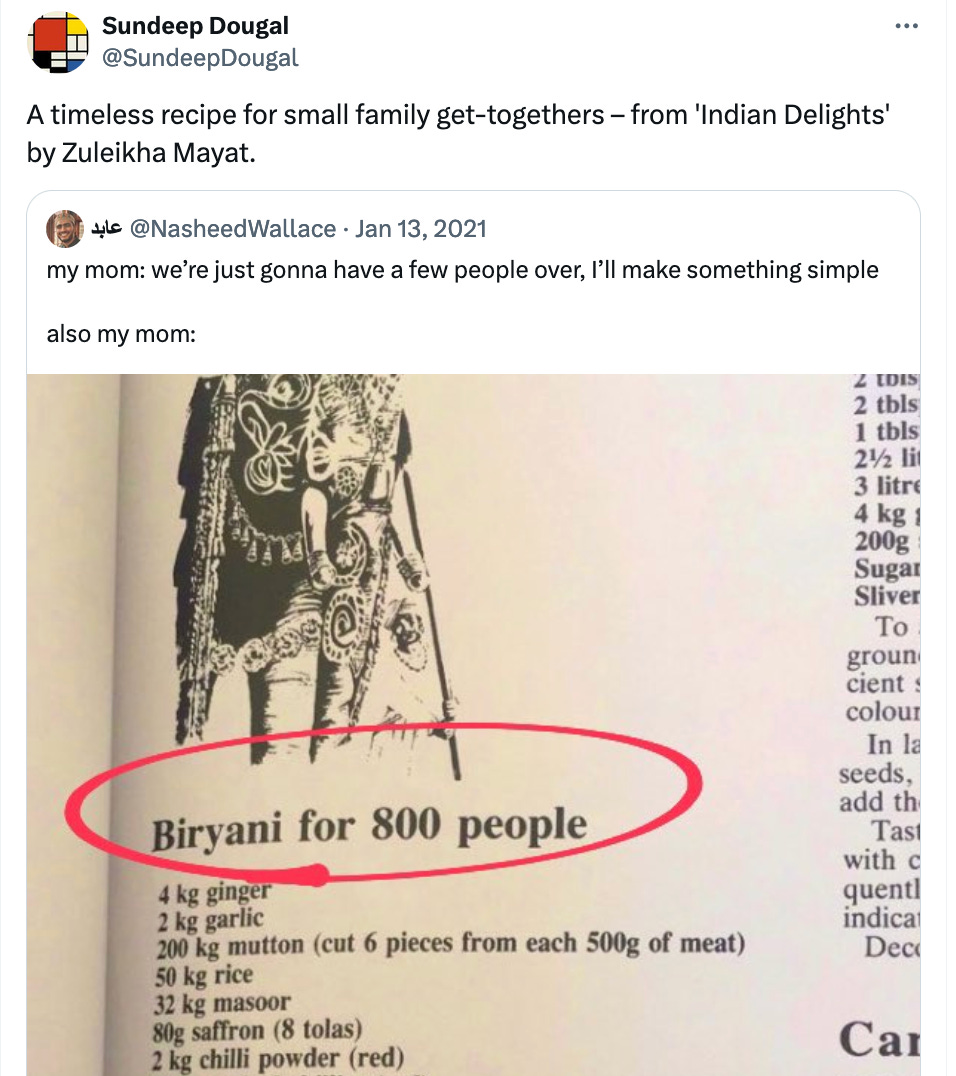Links: Looking below the hood of the Indian economy, plus more election analysis
Also, a biryani recipe for 800 people.
Welcome back to India Inside Out. A month on from the surprising Indian election results, there are still pieces breaking down that verdict and its fallout that are worth reading, some of which I’ve collected here. Next week, Modi in Russia – and more.
But first, a few plugs:
I turned up on BBC’s The Briefing Room to explain what happened in the Indian elections and what the result means for Modi and the BJP.
On the Election Tricycle, we quizzed Tom Hamilton about Labour’s massive election victory, why the headline numbers are a bit deceptive, and what all of this means for other parties (the Tories, Reform, Lib-Dems, the Greens) in the UK.
Election Links
Yogendra Yadav, Rahul Shastri and Shreyas Sardesai point out that “two different BJPs that contested this election: BJP (Establishment) and BJP (Challenger). The Establishment suffered serious electoral reversals, while the Challenger had a good electoral outing.”
See also the authors’ on why the 2024 results are not a ringing endorsement of secularism, democratic India.
Ajaz Ashraf points out that the INDIA grouping’s electoral cohesion could be on shaky grounds if the Congress attempts to expand into its partners’ territories:
“Gandhi’s Congress can now be said to represent the Hindu Left, as opposed to the Hindu Right, the ideological space the BJP occupies… Any attempt of a confident Congress to forge a base among subaltern groups will pose a mortal threat to the SP, which barely exists outside Uttar Pradesh. It will not countenance its support base being poached by the Congress. The Grand Old Party will have to choose between sacrificing its interests and keeping intact the existing political bulwark against the BJP in Uttar Pradesh.”
Milan Vaishnav, in the Journal of Democracy, makes a broader argument about the India of today, despite the BJP’s electoral setback:
“On its face, the BJP's narrow 2024 victory suggests a return to the earlier coalition era. But while the ruling party may be weakened, the nature of the political order has fundamentally shifted in ways that will have a lasting impact on Indian democracy. We are witnessing the dawn of India's "Second Republic," an inflection point that is equal in magnitude to India's constitutional moment of 1950, when the "First Republic" was established.”
Ghazala Jamil on the BJP’s paradoxical defeat in Faizabad, where Ayodhya sits.
Gutta Rohith looks at the backlash against Reddy dominance in Andhra Pradesh.
Two pieces on the media in India, in light of the election results: Mukul Kesavan, arguing that India deserves better news media and Vanita Kohli-Khandekar on how India’s corporate-owned media houses don’t cater to the 41 crore (410 million) people who voted against Modi.
Prateek Goyal on how the Congress, seen as the weakest link in its alliance in Maharashtra, turned the ship around.
Sanya Dhingra on how the RSS is ‘conflicted’ about UP Chief Minister Yogi Adityanath.
Sampad Patnaik explains why Adivasis are now beginning to dominate Odisha politics.
What enabled the SP to achieve its surprising numbers? Arun Kumar argues that it is “the rise of a new subaltern class in the neo-liberal economy that holds the key to future political debates. Those who are in search of jobs or are precariously employed with poor salaries and minimal social security benefits make up this new subaltern.”
Harsh Mander on Indian Muslims and the crisis of non-belonging:
“The success of the BJP-Rashtriya Swayamsevak Sangh juggernaut driven by Modi is not just that the BJP has ensured virtually no representation of Muslims in Parliament and state legislatures. Its even greater triumph is that parties across the spectrum of the political Opposition – including the Congress – that claim fidelity to India’s secular democratic Constitution are balking at choosing Muslims as candidates to fight elections outside Jammu and Kashmir and a few other constituencies of high Muslim concentration. This is the triumph of the political project of Hindutva and it is enabled by the supine surrender to the political agenda of the BJP-Sangh by the non-BJP Opposition.”
JP Nadda last official day as BJP President was supposed to be June 30. DK Singh examines why the party doesn’t yet have a new leader. (See also the author on signs of democracy within the BJP post the elections).
Linking Out
India’s post-Covid economic fundamentals appear sound. Yet, writes Rathin Roy, under the hood, alarm bells are ringing:
“The contemporary Indian economy is one where:
45 percent of the labour force works in agriculture
The share of manufacturing in GDP has fallen to 13 per cent.
800 million people need subsidised food.
Over 100 million people between the ages of 18 and 35 are neither in education nor actively looking for employment.
Such an economy can support neither increased household consumption, nor saving… This is not a new story in the history of development. It is, in fact, the default. From the Philippines to Thailand, from Egypt to Brazil, countries have experienced “prosperity failure” — a trap of their own making from which exit is near impossible. Even as they exited LDC levels, there was no diffusion of prosperity to the general populace. All the problems of poor countries — poverty, malnutrition, poor education, ill health, third-rate housing, difficult public transport, poor sanitation — persisted, even as the rich enjoy globally opulent lifestyles….
My hope has always been that India will join the minority of nations that will secure a successful development transformation. But looking under the hood, I see India on the terrible, but commonplace, road to prosperity failure.”“Why is private investment stagnant despite several steps by the government and vibrant animal spirits about the country’s economic prospects?” asks Gulzar Natarajan, eventually concluding that he is “inclined to believe that the primary reason for the anaemic investment growth is the consumer. Specifically, the signatures of consumption growth across segments may not merit a supply response that’s more than the current one. In other words, the slow pace of investment growth is only a reflection of the demand weaknesses.”
(See also Neelkanth Mishra on the household spending question).Josh Felman and Arvind Subramanian responded to the election result with a simple question, and a suggested answer:
“How is it possible that the electorate chastised rather than handsomely rewarded a leader who has presided over an astonishing economic boom? … We would suggest that growth has not been as dynamic as the official numbers suggest, nor has it been very balanced. Put another way, the overall pie has not grown sufficiently rapidly and it has been shared unequally, but in a different manner than believed.”
The authors also have some thoughts on the India’s struggle to pull in FDI, arguing that it’s all down to ‘risk’, and some findings on revenue performance after 7 years of the GST.
Rajeswari Sengupta says the government shouldn’t spend the unexpectedly large dividend it received from the RBI and should instead pare down debt, unless…
“Why does the government need to stimulate an economy that is doing so well? Given the strong economic performance, it should instead use the surplus dividend from the RBI to bring the fiscal deficit down closer to three per cent.
There is, however, a caveat to this discussion. And this relates to the true state of the Indian economy. What if the economy is actually weaker than what the 7-8 per cent growth figures suggest? Then there may be a case for the government to keep spending to support the economy.”
Menaka Doshi explains what India’s inclusion in JP Morgan’s Emerging Bond Index may mean for Indian markets:
“This is a 1994 moment for India's sovereign bonds, Arvind Chari, the London-based chief investment officer of Q India (UK), said, recalling the year Indian equities debuted on the MSCI Emerging Markets Index and kickstarted foreign investment in the country's listed enterprises. Today, foreign portfolio investors own almost a fifth of India's $5 trillion equity market…
Higher demand for sovereign bonds will put yields under pressure as has already happened in small measure. Over time this could lower government borrowing costs — provided of course that borrowings don't rise…
In time, global investor interest in India's sovereign bonds will spill over to the local corporate bond market, as was witnessed in China, according to an Invesco note. Still, it warns that international funds are quick to react to both local and global economic conditions, making index inclusion a double-edged sword.”
Anumeha Yadav reports from a heat ward at a hospital in India’s searingly hot capital:
Between May 23 and June 18 – a period of 26 days – Safdarjung hospital received 27 patients suffering from heat-related illness, hospital data shows. Four of them died. But after June 19, the warmest night recorded since 1964, the number of patients reaching the hospital with heat exhaustion and heatstroke increased to 33 in 48 hours. Rohit was one of them. The hospital recorded a total of 13 deaths between June 19 and 20, a hospital spokesperson said on Thursday. “We saw people reaching in an unconscious state, some were breathing with difficulty, some were even frothing at the mouth (from seizure),” one security guard who was on duty on Wednesday night told The Migration Story.
“Delhi is forecast to become the world’s most populous urban conglomeration, overtaking Tokyo by 2028, according to the United Nations,” writes Sayantan Bera. “What has happened so far this year may only be a trailer of what is to come. In less than a decade, the prerequisites of a healthy life—clean air, potable water and bearable temperatures—could be out of the reach of a large chunk of its residents… Being a melting pot of adverse environmental factors, the city leaves its residents with about 60-80 days of liveable conditions in a year (between February and April).”
Kamayani Sharma on why these travel posters sparked a fiery debate between Indian and British legislators in the 1930s.
Can’t Make This Up
That’s it for India Inside Out this week. Thanks for reading, and reply to this email with links, suggestions, and screenshots for our ‘Can’t Make This Up’ section.








